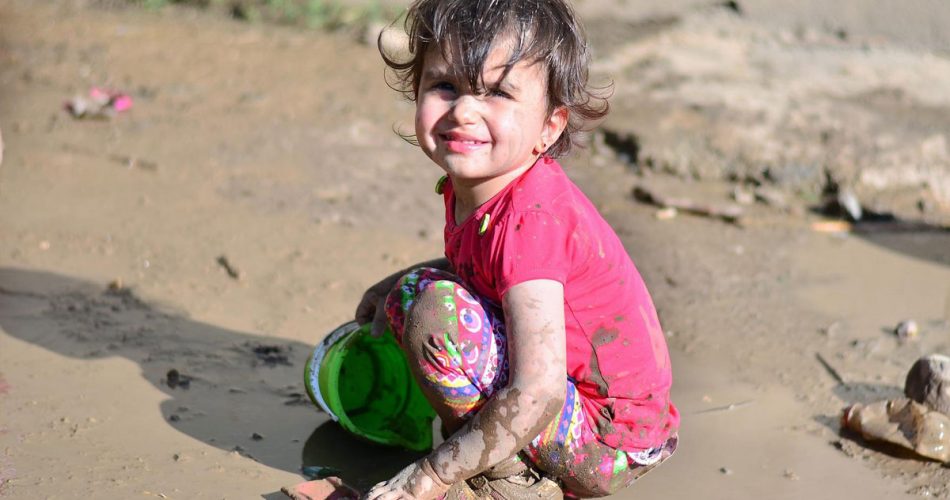Think back to your earliest memories of mud. Did you make mud pies in your imaginary outdoor kitchen? Poke at it with a stick? Jump in a puddle and feel the mud squish and splash under your feet?
Mud is one of childhood’s simple joys. And it’s also a great learning tool.
We spoke with an early childhood director who has included intentional mud play in her center’s programming for over 25 years.
Eve Hoskins is director of Ehmke’s Childhaven Preschool in Show Low, Arizona, a Quality First participating child care center in the First Things First Navajo/Apache region.
Whether you’re thinking about how to add mud play to your program or just curious, read on for Eve’s insights and tips.
Where did you get the idea for mud play, and what resources do you need?
During so much of the children’s lives they are told, “Don’t get messy.” This is a way we can say, “It’s okay. You can get messy today.”
Mud play is just an old-fashioned way for kids to get sensory play. We grew up doing it in our yard as kids, and I think it’s just something that is an easy way for kids to play in the water and cool off. For us, it just screams summer.
The beauty of mud play is you don’t need much. It’s just a hose with a sprinkler and some dirt. Add a few toys and a child in old clothing, and you’re all set.
How do you include mud play at your program?
All summer long, we incorporate mud play on the playground. Each classroom gets the chance for mud play one day out of the week. Because of our weather, summer is the only time we can do it.
It’s simple. We ask the families to bring their kids in old clothes that they don’t mind getting muddy. An old pair of shorts and t-shirt is best. (We help the child change into clean clothes when mud play is over.) We put a sprinkler in the sand area and run it for the first 30 minutes of outdoor play. Then we turn the sprinkler off for the next 30 minutes, and the kids are left with the puddle to play in. They use scoops, shovels and buckets to play in the mud.
What do you notice when you observe mud play?
What stands out for me is the creativity. What the kids do with it. Also, the different experiences that children have. Some children like it and others don’t get as involved. We have some children that prefer to play on the structures and play in the sand but don’t want to get wet.
There are always learning moments. There are opportunities for social development. For example, a lot of the children want to run through the sprinkler at the same time, so the teachers have a chance to talk with them about how to make sure everyone gets a turn to do that safely. They talk with the children about how to keep their friends from getting hurt. Yes, throwing mud is fun but if it gets in your eyes, it hurts. So the teachers help the children think about ways to keep themselves and their friends safe so everyone can have a good time. There are opportunities to connect concepts from the topic of study and the children’s lives outside of school. For example, the children enjoy digging channels for the water to flow through. A teacher might connect to the topic of camping by noticing the channel’s similarity to a river and ask, “When you go camping, do you camp near a river?” These questions spur lively conversations and plenty of learning.
How is this practice improving the quality of your program, and what have others noticed?
The families love it. They think it’s something fun and extra for their kids to do. It’s fun for the teachers. Some of them get more into it than others. We had a teacher who would wear her old shorts and t shirt and she would get out there and get into it as much as they did. It is also nice for the teachers because it is one less activity for them to plan.
What would you tell a colleague if they were interested in incorporating similar ideas?
Talk with the families to let them know what you are planning, and have them bring the kids in old clothes. We don’t allow swimsuits since it exposes too much skin and increases the risk of sunburn.
Don’t be afraid of it. Just do it. Mud play is an easy way for the kids to have a fun and engaging experience. In early childhood we focus on the process of learning through experiences, and supporting creativity in open-ended ways. This is a way for them to just play and not be directed by anything.
Resources around the web
Mud Day — The World Forum Foundation’s Mud Day page is dedicated to all things mud. Learn more about the history of the day, access printable promotional materials and social media links to get hyped for the celebration.
Muddy Play: Reflections on Young Children’s Outdoor Learning in an Urban Setting — NAEYC’s Young Children publication features observations and insights about mud play from an early childhood educator.
Mud Day Song — The staff and children at Bold Park Community School wrote a song, “Mud Day Finally Here”, to commemorate the day.
“Who Likes Mud?” Book — Written by NACC leader Swati Popat, “Who Likes Mud?” is a story that explores the world of mud, the animals who like mud, a seed that needs mud and worms that make it matter! Click here to download the PDF.
At Quality First, we love to hear from you! Share your new and innovative practices by emailing us at qualityfirst@firstthingsfirst.org.
